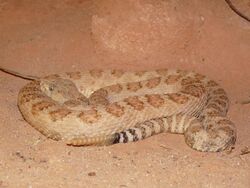Biology:Crotalus oreganus abyssus
| Crotalus oreganus abyssus | |
|---|---|

| |
| Grand Canyon rattlesnake Havasu Canyon, Arizona | |
| Scientific classification | |
| Domain: | Eukaryota |
| Kingdom: | Animalia |
| Phylum: | Chordata |
| Class: | Reptilia |
| Order: | Squamata |
| Suborder: | Serpentes |
| Family: | Viperidae |
| Genus: | Crotalus |
| Species: | |
| Subspecies: | C. o. abyssus
|
| Trinomial name | |
| Crotalus oreganus abyssus Klauber, 1930
| |
| Synonyms | |
Crotalus oreganus abyssus is a venomous pit viper subspecies[3] found only in the U.S. states of Arizona and Utah.
Description
This is a medium to large rattlesnake. Adults measure 16–54 inches (41–137 cm) in total length.
Dorsally, they have dark blotches on a variety of base colors ranging from reddish, pink, yellow/green, light tan, to gray. The blotches usually become crossbands near the tail. The young usually have more prominent blotches and facial markings than the adults. Some adults have no body markings.
The rostral scale usually comes into contact with more than 2 internasal scales.
Geographic range
Found in northwestern and north-central Arizona along both rims and the floor of the Grand Canyon and adjacent areas,, and North into Utah on the Kaiparowits Plateau between the Escalante River and Paria River Drainages of Kane and Garfield Counties, Utah.[5][6][7][8]
Habitat
The snake is found in a variety of habitats, including grassland, Great Basin Desert scrubland, bottoms in the Grand Canyon, talus and cliff slopes, rolling hills and bajadas in pinion-juniper woodland, and pine forests.
Behavior
It is primarily diurnal but can be active around the clock when conditions are favorable. The cryptic coloration and calm demeanor of this subspecies often allows it to escape detection from passersby.
Feeding
It feeds on squirrels, mice, lizards, and birds.
Taxonomy notes
Some researchers list this taxon as elevated to a full species as (Crotalus abyssus),[9] or as a subspecies of the Great Basin Rattlesnake (Crotalus lutosus) as (Crotalus lutosus abyssus), in the Annotated Checklist of the Rattlesnakes (Second Edition), published in The Biology of Rattlesnakes II 2017.[10]
References
- ↑ McDiarmid RW, Campbell JA, Touré T. 1999. Snake Species of the World: A Taxonomic and Geographic Reference, vol. 1. Herpetologists' League. 511 pp. ISBN:1-893777-00-6 (series). ISBN:1-893777-01-4 (volume).
- ↑ Ashton KG, de Queiroz A. 2001. Molecular systematics of the western rattlesnake, Crotalus viridis (Viperidae), with comments on the utility of the d-loop in phylogenetic studies of snakes. Molecular Phylogenetics and Evolution, Vol. 21, No.2, pp. 176–189. PDF at CNAH. Accessed 3 September 2008.
- ↑ 3.0 3.1 "Crotalus oreganus abyssus". Integrated Taxonomic Information System. https://www.itis.gov/servlet/SingleRpt/SingleRpt?search_topic=TSN&search_value=683061. Retrieved 28 November 2006.
- ↑ Wright AH, Wright AA. 1957. Handbook of Snakes. Comstock Publishing Associates. (7th printing, 1985). 1105 pp. ISBN:0-8014-0463-0.
- ↑ Gordon W. Schuett, Martin J. Feldner, Charles F. Smith, Randall S. Reiserer. 2016. Rattlesnakes of Arizona Vol. 1. 736 pp. ISBN:978-1938850189.
- ↑ Gordon W. Schuett, Charles F. Smith, Bob Ashley. 2018. Rattlesnakes of the Grand Canyon. 131 pp. ISBN:978-1938850585.
- ↑ Jonathan A. Campbell, William W. Lamar. 2004. The Venomous Reptiles of the Western Hemisphere, Vols.1 & 2. 976 pp. ISBN:978-0801441417.
- ↑ Brian Hubbs, Brendan O'Connor. 2012. A Guide to the Rattlesnakes and other Venomous Serpents of the US. 132 pp. ISBN:978-0975464137.
- ↑ Gordon W. Schuett, Martin J. Feldner, Charles F. Smith, Randall S. Reiserer. 2016. Rattlesnakes of Arizona Vol. 1. 736 pp. ISBN:978-1938850189
- ↑ Kent R. Beaman, and William K. Hayes. 2017. The Biology of Rattlesnakes II 236 pp. ISBN:1938850548 ISBN:978-1938850547
Further reading
- Klauber, L.M. 1930. New and Renamed Subspecies of Crotalus confluentus Say, with Remarks on Related Species. Trans. San Diego Soc. Nat. Hist.
6 (3): 95–144, including Plates 9–12, 1 map. ("Crotalus confluentus abyssus, subsp. nov.", pp. 114–117 + Plate 11, figure 1.)
External links
| Wikimedia Commons has media related to Crotalus oreganus. |
- Crotalus oreganus at the Reptarium.cz Reptile Database. Accessed 12 December 2007.
- Images of Crotalus oreganus abyssus at California Reptiles and Amphibians. Accessed 18 June 2008.
Wikidata ☰ Q5188956 entry
 |

